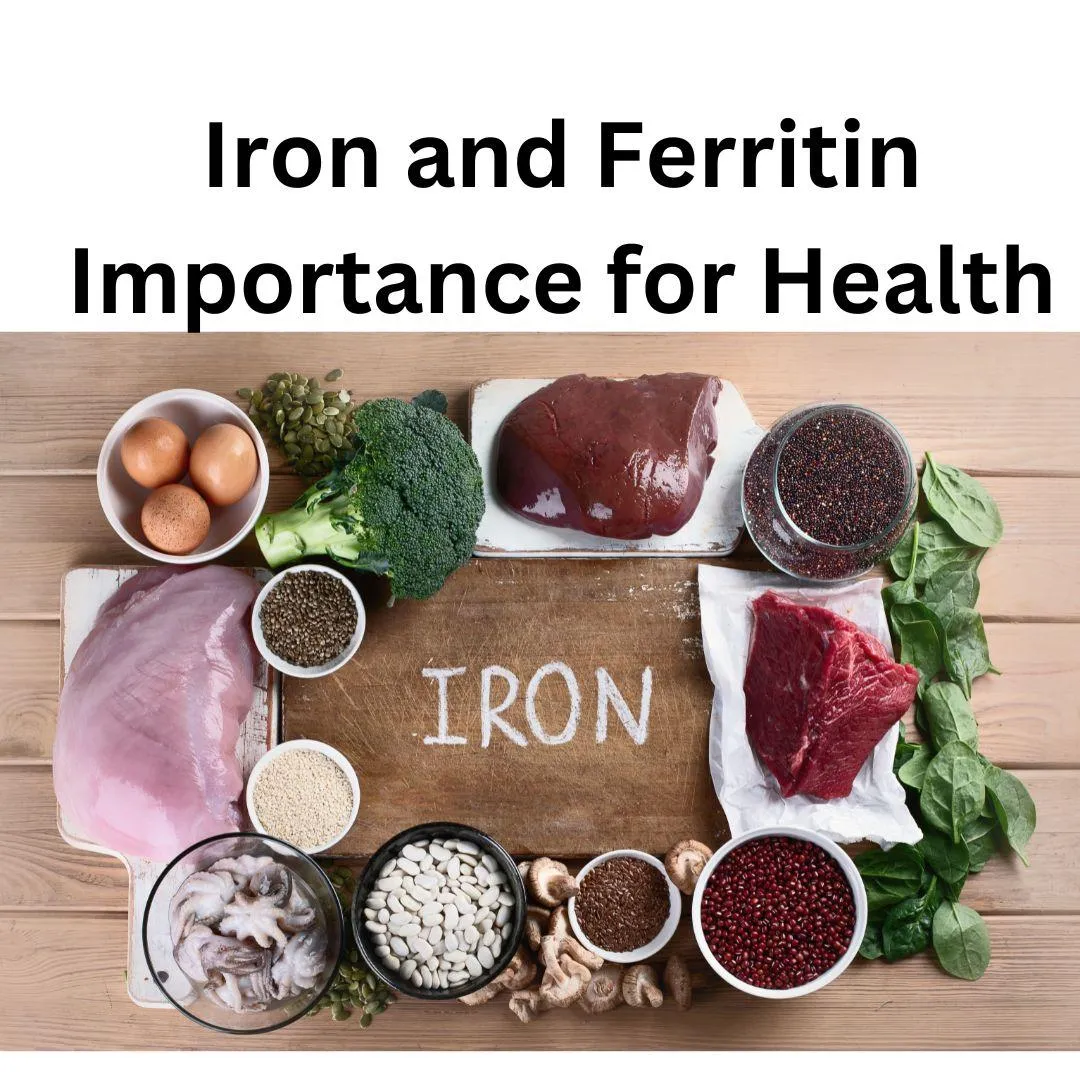*Open to Florida Residents
Blog
Blog

Iron and Ferritin Guide
Iron and ferritin play important roles in maintaining human health, particularly in supporting hormone formation, immunoglobulin development, and red blood cell production. This comprehensive guide explores their functions, optimal levels, deficiency symptoms, factors affecting their absorption, and dietary considerations.
The Role of Iron in Hormone Formation and Immunoglobulin Development
Hormone Formation:
Iron is crucial in synthesizing several hormones, including thyroid hormones like thyroxine (T4) and triiodothyronine (T3). These hormones regulate metabolic rate, energy production, and overall physiological balance. Enzymes such as thyroperoxidase, which require iron as a cofactor, are essential to produce these hormones.
In addition, iron influences adrenal hormones, such as cortisol, which are critical for stress response and maintaining blood pressure. Without sufficient iron, these hormonal pathways can become disrupted, leading to fatigue, weight gain, or mood disturbances.
Immunoglobulin Development:
Iron is integral to the immune system, particularly in the development of immunoglobulin (antibodies). Immunoglobulins are proteins that recognize and neutralize pathogens. Adequate iron levels support the production and functioning of these proteins, helping the body defend against infections.
Ferritin and Red Blood Cell Formation in Bone Marrow
Ferritin is a storage protein that holds iron in a bioavailable form, releasing it when needed. In the bone marrow, ferritin provides the necessary iron for the synthesis of hemoglobin, a protein in red blood cells responsible for oxygen transport. Without sufficient ferritin, red blood cell production can diminish, leading to anemia and its associated symptoms.
Ideal Ferritin and Iron Levels
Ferritin Levels:
Optimal Range: Varies based on lab test configuration, for most adults' ferritin levels are between 50-100ng/ml are considered healthy in modern medicine. However, for true optimization found that 80- 100ng/ml to be the best.
Deficiency: Levels below 15-50 ng/ml suggest iron deficiency.
Excess: Levels above 300ng/ml may indicate iron overload or inflammatory conditions.
Iron Levels:
Serum Iron: Normal serum iron levels vary based on lab test configuration; most range between 60-170mcg/dl. Optimal iron ranges are between 80-120 mcg/dl.
Transferrin Saturation: Optimal values are 20-50%. Optimal is around the 50% level.
Total Iron Binding Capacity (TIBC): Normal TIBC ranges from 240-450 mcg/dl.
Symptoms of Low Iron and Low Ferritin
Low Iron:
Fatigue and weakness
Shortness of breath
Dizziness or lightheadedness
Pale skin
Brittle nails
Cold Intolerance
Low Ferritin:
Hair Loss
Restless Leg Syndrome
Poor Wound Healing
Frequent Infections
Cognitive Impairment
Irritability
Factors Impacting Iron and Ferritin Levels
Several factors can influence iron and ferritin levels, including:
Dietary intake: insufficient consumption of iron rich foods.
Absorption issues: conditions like celiac disease or Crohn’s disease can impair iron absorption.
Blood loss: Menstruation, gastrointestinal bleeding, or surgery can reduce iron stores.
Inflammation: Chronic inflammation can lower ferritin by reducing iron availability.
Pregnancy: Increased demand for iron during pregnancy can deplete stores.
Factors Affecting Iron and Ferritin Absorption
Enhancers of Absorption:
Vitamin C: converts non-heme iron into a more absorbable form.
Heme Iron: found in animal sources, it is absorbed more efficiently than non-heme iron.
Acidic Environment: Stomach acid aids in iron absorption.
Inhibitors of Absorption:
Phytates: found in whole grains and legumes.
Calcium: competes with iron for absorption.
Polyphenols: present in tea, coffee and red wine.
Certain Medications: antacids, and proton pump inhibitors reduce stomach acidity, impairing absorption.
Best Food Sources for Iron and Ferritin
Heme-Iron (animal-based sources):
Red meat such as beef, lamb, elk, bison
Poultry such as chicken and turkey
Fish such as salmon and tuna
Organ meats such as liver and kidney
Non-Heme Iron (plant-based sources)
Legumes such as lentils, chickpeas and beans.
Tofu and tempeh
Spinach and kale
Fortified cereals and bread
Nuts and seed such as pumpkin seeds and cashews.
Ferritin and storage of iron
While ferritin itself is not obtained from the diet, maintaining iron-rich nutrition ensures adequate storage levels. Pairing iron rich foods with Vitamin C sources enhances absorption.
The Role of Vitamin C in Iron Supplement Absorption
Vitamin C, ascorbic acid, enhances the absorption of non-heme iron by converting ferric iron into ferrous iron which is more readily absorbed in the intestines. Consuming iron supplements with a source of vitamin C, such as orange juice, improves efficacy.
Why Heme-Based Iron Supplements are Best
Heme based iron supplements are derived from animal sources and are more bioavailable than non-heme iron supplements. The reason is that they
Bypass the need for conversion processes.
Are less affected by dietary inhibitors.
Cause fewer gastrointestinal side effects compared to non-heme iron supplements.
Conclusion
Iron and ferritin are essential for numerous physiological functions, from hormone synthesis to immune defense and red blood cell formation. Understanding their roles, maintaining optimal levels, and addressing deficiencies through diet and supplements can significantly improve overall health. Red blood cells only live for 100 days, because of this they must have an adequate supply of iron daily. Incorporating heme iron sources and pairing iron intake with Vitamin C are practical steps to enhance absorption and utilization.
Disclaimer:
This content is for informational and educational purposes only. It is not intended to provide medical advice or to take the place of medical advice or treatment from a personal health care professional. All viewers of this content are advised to consult their own qualified health professionals regarding specific health questions. Neither Vivien Murphy, or Elite Sexual Hormone Health takes responsibility for possible health consequences of any person or persons reading or following the information in this educations content. All viewers of this content, especially those taking prescription or over the counter medications should consult their medical providers before beginning any nutrition, supplement or lifestyle program.

Iron and Ferritin Guide
Iron and ferritin play important roles in maintaining human health, particularly in supporting hormone formation, immunoglobulin development, and red blood cell production. This comprehensive guide explores their functions, optimal levels, deficiency symptoms, factors affecting their absorption, and dietary considerations.
The Role of Iron in Hormone Formation and Immunoglobulin Development
Hormone Formation:
Iron is crucial in synthesizing several hormones, including thyroid hormones like thyroxine (T4) and triiodothyronine (T3). These hormones regulate metabolic rate, energy production, and overall physiological balance. Enzymes such as thyroperoxidase, which require iron as a cofactor, are essential to produce these hormones.
In addition, iron influences adrenal hormones, such as cortisol, which are critical for stress response and maintaining blood pressure. Without sufficient iron, these hormonal pathways can become disrupted, leading to fatigue, weight gain, or mood disturbances.
Immunoglobulin Development:
Iron is integral to the immune system, particularly in the development of immunoglobulin (antibodies). Immunoglobulins are proteins that recognize and neutralize pathogens. Adequate iron levels support the production and functioning of these proteins, helping the body defend against infections.
Ferritin and Red Blood Cell Formation in Bone Marrow
Ferritin is a storage protein that holds iron in a bioavailable form, releasing it when needed. In the bone marrow, ferritin provides the necessary iron for the synthesis of hemoglobin, a protein in red blood cells responsible for oxygen transport. Without sufficient ferritin, red blood cell production can diminish, leading to anemia and its associated symptoms.
Ideal Ferritin and Iron Levels
Ferritin Levels:
Optimal Range: Varies based on lab test configuration, for most adults' ferritin levels are between 50-100ng/ml are considered healthy in modern medicine. However, for true optimization found that 80- 100ng/ml to be the best.
Deficiency: Levels below 15-50 ng/ml suggest iron deficiency.
Excess: Levels above 300ng/ml may indicate iron overload or inflammatory conditions.
Iron Levels:
Serum Iron: Normal serum iron levels vary based on lab test configuration; most range between 60-170mcg/dl. Optimal iron ranges are between 80-120 mcg/dl.
Transferrin Saturation: Optimal values are 20-50%. Optimal is around the 50% level.
Total Iron Binding Capacity (TIBC): Normal TIBC ranges from 240-450 mcg/dl.
Symptoms of Low Iron and Low Ferritin
Low Iron:
Fatigue and weakness
Shortness of breath
Dizziness or lightheadedness
Pale skin
Brittle nails
Cold Intolerance
Low Ferritin:
Hair Loss
Restless Leg Syndrome
Poor Wound Healing
Frequent Infections
Cognitive Impairment
Irritability
Factors Impacting Iron and Ferritin Levels
Several factors can influence iron and ferritin levels, including:
Dietary intake: insufficient consumption of iron rich foods.
Absorption issues: conditions like celiac disease or Crohn’s disease can impair iron absorption.
Blood loss: Menstruation, gastrointestinal bleeding, or surgery can reduce iron stores.
Inflammation: Chronic inflammation can lower ferritin by reducing iron availability.
Pregnancy: Increased demand for iron during pregnancy can deplete stores.
Factors Affecting Iron and Ferritin Absorption
Enhancers of Absorption:
Vitamin C: converts non-heme iron into a more absorbable form.
Heme Iron: found in animal sources, it is absorbed more efficiently than non-heme iron.
Acidic Environment: Stomach acid aids in iron absorption.
Inhibitors of Absorption:
Phytates: found in whole grains and legumes.
Calcium: competes with iron for absorption.
Polyphenols: present in tea, coffee and red wine.
Certain Medications: antacids, and proton pump inhibitors reduce stomach acidity, impairing absorption.
Best Food Sources for Iron and Ferritin
Heme-Iron (animal-based sources):
Red meat such as beef, lamb, elk, bison
Poultry such as chicken and turkey
Fish such as salmon and tuna
Organ meats such as liver and kidney
Non-Heme Iron (plant-based sources)
Legumes such as lentils, chickpeas and beans.
Tofu and tempeh
Spinach and kale
Fortified cereals and bread
Nuts and seed such as pumpkin seeds and cashews.
Ferritin and storage of iron
While ferritin itself is not obtained from the diet, maintaining iron-rich nutrition ensures adequate storage levels. Pairing iron rich foods with Vitamin C sources enhances absorption.
The Role of Vitamin C in Iron Supplement Absorption
Vitamin C, ascorbic acid, enhances the absorption of non-heme iron by converting ferric iron into ferrous iron which is more readily absorbed in the intestines. Consuming iron supplements with a source of vitamin C, such as orange juice, improves efficacy.
Why Heme-Based Iron Supplements are Best
Heme based iron supplements are derived from animal sources and are more bioavailable than non-heme iron supplements. The reason is that they
Bypass the need for conversion processes.
Are less affected by dietary inhibitors.
Cause fewer gastrointestinal side effects compared to non-heme iron supplements.
Conclusion
Iron and ferritin are essential for numerous physiological functions, from hormone synthesis to immune defense and red blood cell formation. Understanding their roles, maintaining optimal levels, and addressing deficiencies through diet and supplements can significantly improve overall health. Red blood cells only live for 100 days, because of this they must have an adequate supply of iron daily. Incorporating heme iron sources and pairing iron intake with Vitamin C are practical steps to enhance absorption and utilization.
Disclaimer:
This content is for informational and educational purposes only. It is not intended to provide medical advice or to take the place of medical advice or treatment from a personal health care professional. All viewers of this content are advised to consult their own qualified health professionals regarding specific health questions. Neither Vivien Murphy, or Elite Sexual Hormone Health takes responsibility for possible health consequences of any person or persons reading or following the information in this educations content. All viewers of this content, especially those taking prescription or over the counter medications should consult their medical providers before beginning any nutrition, supplement or lifestyle program.
Let me help you achieve your goals.
Disclaimer: We understand that every individual's experience is unique and results may vary depending on various factors, such as attitude, adaptability, personal history, and overall health. For your safety and well-being, we highly recommend consulting your physician before beginning any program. At Elite Sexual Hormone Health, we do not diagnose, treat, or prescribe any medical or psychological disorders. We urge you to seek the care of a qualified physician or psychotherapist if you suffer from any psychological or medical disorder. Thank you for choosing Elite Sexual Hormone Health as your partner in your journey towards wellness.
© 2025, Elite Sexual Hormone Health. All rights reserved.
Privacy Policy | Terms of Service | Disclaimer
© 2025, Elite Sexual Hormone Health. All rights reserved.
Website by Hypnotherapy Accelerator





